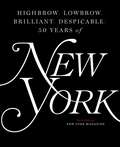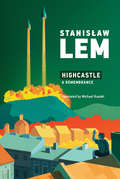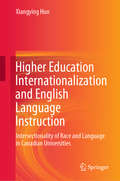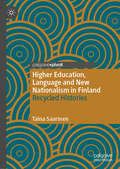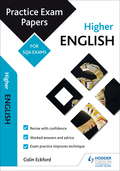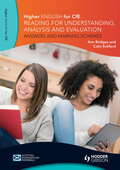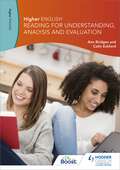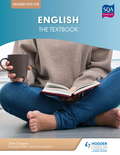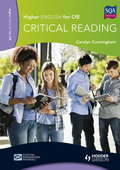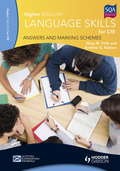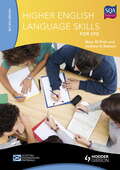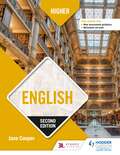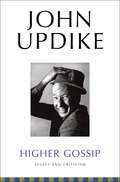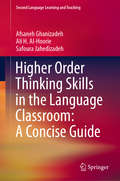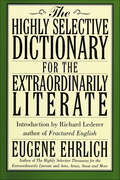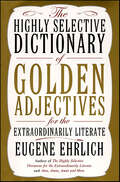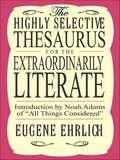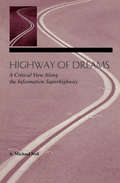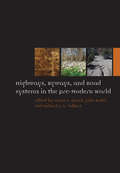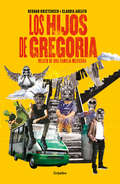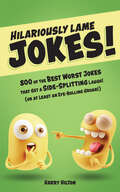- Table View
- List View
Highbrow, Lowbrow, Brilliant, Despicable: Fifty Years of New York Magazine
by The Editors of New York MagazineNew York, the city. New York, the magazine. A celebration.The great story of New York City in the past half-century has been its near collapse and miraculous rebirth. A battered town left for dead, one that almost a million people abandoned and where those who remained had to live behind triple deadbolt locks, was reinvigorated by the twinned energies of starving artists and financial white knights. Over the next generation, the city was utterly transformed. It again became the capital of wealth and innovation, an engine of cultural vibrancy, a magnet for immigrants, and a city of endless possibility. It was the place to be—if you could afford it. Since its founding in 1968, New York Magazine has told the story of that city’s constant morphing, week after week. Covering culture high and low, the drama and scandal of politics and finance, through jubilant moments and immense tragedies, the magazine has hit readers where they live, with a sensibility as fast and funny and urbane as New York itself. From its early days publishing writers like Tom Wolfe, Jimmy Breslin, and Gloria Steinem to its modern incarnation as a laboratory of inventive magazine-making, New York has had an extraordinary knack for catching the Zeitgeist and getting it on the page. It was among the originators of the New Journalism, publishing legendary stories whose authors infiltrated a Black Panther party in Leonard Bernstein’s apartment, introduced us to the mother-daughter hermits living in the dilapidated estate known as Grey Gardens, launched Ms. Magazine, branded a group of up-and-coming teen stars “the Brat Pack,” and effectively ended the career of Roger Ailes. Again and again, it introduced new words into the conversation—from “foodie” to “normcore”—and spotted fresh talent before just about anyone. Along the way, those writers and their colleagues revealed what was most interesting at the forward edge of American culture—from the old Brooklyn of Saturday Night Fever to the new Brooklyn of artisanal food trucks, from the Wall Street crashes to the hedge-fund spoils, from The Godfather to Girls—in ways that were knowing, witty, sometimes weird, occasionally vulgar, and often unforgettable. On “The Approval Matrix,” the magazine’s beloved back-page feature, New York itself would fall at the crossroads of highbrow and lowbrow, and more brilliant than despicable. (Most of the time.) Marking the magazine’s fiftieth birthday, Highbrow, Lowbrow, Brilliant, Despicable: 50 Years of New York draws from all that coverage to present an enormous, sweeping, idiosyncratic picture of a half-century at the center of the world. Through stories and images of power and money, movies and food, crises and family life, it constitutes an unparalleled history of that city’s transformation, and of a New York City institution as well. It is packed with behind-the-scenes stories from New York’s writers, editors, designers, and journalistic subjects—and frequently overflows its own pages onto spectacular foldouts. It’s a big book for a big town.
Highcastle: A Remembrance
by Stanislaw LemA playful, witty, reflective memoir of childhood by the science fiction master Stanisław Lem. With Highcastle, Stanisław Lem offers a memoir of his childhood and youth in prewar Lvov. Reflective, artful, witty, playful—“I was a monster,” he observes ruefully—this lively and charming book describes a youth spent reading voraciously (he was especially interested in medical texts and French novels), smashing toys, eating pastries, and being terrorized by insects. Often lonely, the young Lem believed that he could communicate with household objects—perhaps anticipating the sentient machines in the adult Lem's novels. Lem reveals his younger self to be a dreamer, driven by an unbridled imagination and boundless curiosity. In the course of his reminiscing, Lem also ponders the nature of memory, innocence, and the imagination. Highcastle (the title refers to a nearby ruin) offers the portrait of a writer in his formative years.
Higher Education Internationalization and English Language Instruction: Intersectionality of Race and Language in Canadian Universities
by Xiangying HuoThis book offers new understanding of the implications of pluralism and of transnational movements to higher education and the construct of a “native speaker” within contemporary globalization processes. Theoretically, it calls for a revisioned English as an International Language (EIL) pedagogy and a wider acceptance of EIL and of World Englishes. It challenges the postsecondary education sector to change the discourse around language proficiency to one that engages the “pluralism of English.” As for the applied significance, the book contributes to the work on neo-racism which means racism goes beyond color to stereotypic foreign cultures, nationalities, and exotic accents based on cultural distinctions instead of merely skin differences. The book contributes to higher education policy and practice, pushing a revisioning of ESL in conceptual and pedagogical ways, such as designing more culturally oriented curriculum, implementing culturally responsive pedagogy, and valuing the teaching proficiency more than the language proficiency.
Higher Education, Language and New Nationalism in Finland: Recycled Histories
by Taina SaarinenThe book discusses recycled discourses of language and nationalism in Finnish higher education, demonstrating the need to look beyond language in the study of language policies of higher education. It analyses the historical and political layeredness of language policies as well as the intertwined nature of national and international developments in understanding new nationalism. Finnish higher education language policies were fuelled by the dynamics and tensions between the national languages Finnish and Swedish until the 2000s, when English begins to catalyse post nationalist discourses of economy and competitiveness. In the 2010s, English begins to be seen as a threat to Finnish. Educational, economic and epistemic nationalism emerge as the main cycles of new nationalist language policies in Finnish higher education. The book will be of interest to language policy and higher education scholars and practitioners, as well as graduate students language policy and higher education.
Higher English: Practice Papers for SQA Exams
by Colin EckfordPractise for your SQA exams with three specially-commissioned Hodder Gibson Practice Exam Papers.- Practise with model papers written and checked by experienced markers and examiners- Get extra advice with specially-written study-skills guidance sections- Gain vital extra marks and avoid common mistakes with examiner tips
Higher English for CfE: Reading for Understanding, Analysis and Evaluation - Answers and Marking Schemes
by Ann Bridges Colin EckfordThis book (which is photocopiable within the purchasing institution) provides detailed suggested marking instructions to use alongside the student book of the same name, which offers practice in the Higher element of Reading for Understanding, Analysis and Evaluation - worth 30% of marks in the final exam. Written by two highly experienced authors, the student book introduces the terms and concepts that lie behind success and offers guidance on the interpretation of questions and targeting answers. - Acquire and improve the skills needed for success in this area of CfE Higher - Detailed marking instructions to reflect the style of assessments in this section of the paper - Revise for the exam using the practice papers in the accompanying student book
Higher English for CfE: Reading for Understanding, Analysis and Evaluation
by Ann Bridges Colin EckfordA brand new edition of the former Higher English Close Reading, completely rewritten for the new Higher element - worth 30% of marks in the final exam. Written by two highly experienced authors, this book shows you how to practise for the Reading for Understanding, Analysis and Evaluation section of the CfE Higher English exam. It introduces the terms and concepts that lie behind success and offers guidance on the interpretation of questions and targeting answers.- Acquire and improve the skills needed for success in this area of CfE Higher- Includes questions and passages to reflect the style of assessments in this section of the paper- Revise for the exam using the practice papers and accompanying book of suggested answers
Higher English for CfE: The Textbook
by Jane CooperEnsure your students are prepared for every aspect of their assessment with the only textbook that offers comprehensive coverage of the new syllabus requirements. - Written by a highly experienced bestselling author- Covers the new specification with all the new topics in the SQA examinations- Provides thorough exam preparation, with graded Practice Exercises- Organised to make it easy to plan, manage and monitor student progress
Higher English for CfE: Critical Reading
by Carolyn CunninghamA comprehensive working guide to the Critical Reading section of Higher English for CfE - worth 40% of available marks in the exam. Critical Reading (made up of two sections: Scottish Text and Critical Essay) is a very significant element of the new Higher English qualification. This book provides you with the support and advice you will need to succeed in this vital area, with a top expert guiding you through the course and suggesting approaches to the exam, so that you achieve the best grades you can. By focusing on specific examples of Scottish texts, this book enables you to increase your knowledge and approach any text with greater skill.- Become more secure in your knowledge of texts- Develop your analysis and essay writing skills through studying specific examples of texts, with exam-style questions- Includes revision tips to help you approach the exam with confidence and succeed on the day
Higher English Language for CfE: Answers and Marking Schemes
by Andrew G. Ralston Mary M. FirthThis book (which is photocopiable within the purchasing institution) accompanies the student book of the same name. It is a brand new edition of a bestselling title, updated for the newest CfE Higher English course, and particularly directed at offering support for Paper 1: Reading for Understanding, Analysis and Evaluation. It provides detailed answers and suggested marking instructions to the student book material, and gives you the support and advice you will need to succeed in this element of Higher English- Become more secure in your knowledge of the English language and in your reading skills- Apply those reading skills in learning how to answer questions on close reading- Practise answering questions in the accompanying student book
Higher English Language Skills for CfE
by Mary M. Firth Andrew G. RalstonExam Board: SQALevel: HigherSubject: EnglishFirst Teaching: September 2014First Exam: June 2015This is a brand new edition of a bestselling title, updated for the newest CfE Higher English course, and particularly directed at offering support for Paper 1: Reading for Understanding, Analysis and Evaluation. It provides you with the support and advice you will need to succeed in this element of Higher English, which is worth 30% of the available marks in your examination.- Become more secure in your knowledge of the English language and in your reading skills- Apply those reading skills in learning how to answer questions on close reading- Practise answering questions and check your work using theaccompanying book of suggested answers
Higher English Language Skills for CfE
by Andrew G. Ralston Mary M. FirthThis is a brand new edition of a bestselling title, updated for the newest CfE Higher English course, and particularly directed at offering support for Paper 1: Reading for Understanding, Analysis and Evaluation. It provides you with the support and advice you will need to succeed in this element of Higher English, which is worth 30% of the available marks in your examination.- Become more secure in your knowledge of the English language and in your reading skills- Apply those reading skills in learning how to answer questions on close reading- Practise answering questions and check your work using theaccompanying book of suggested answers
Higher English: Reading for Understanding, Analysis and Evaluation
by Ann Bridges Colin EckfordExam Board: SQALevel: HigherSubject: EnglishFirst Teaching: September 2014First Exam: June 2015A brand new edition of the former Higher English Close Reading, completely rewritten for the new Higher element - worth 30% of marks in the final exam. Written by two highly experienced authors, this book shows you how to practise for the Reading for Understanding, Analysis and Evaluation section of the CfE Higher English exam. It introduces the terms and concepts that lie behind success and offers guidance on the interpretation of questions and targeting answers.- Acquire and improve the skills needed for success in this area of CfE Higher- Includes questions and passages to reflect the style of assessments in this section of the paper- Revise for the exam using the practice papers and accompanying book of suggested answers
Higher English: Reading for Understanding, Analysis and Evaluation - Answers and Marking Schemes
by Ann Bridges Colin EckfordExam Board: SQALevel: HigherSubject: EnglishFirst Teaching: September 2014First Exam: June 2015This book (which is photocopiable within the purchasing institution) provides detailed suggested marking instructions to use alongside the student book of the same name, which offers practice in the Higher element of Reading for Understanding, Analysis and Evaluation - worth 30% of marks in the final exam. Written by two highly experienced authors, the student book introduces the terms and concepts that lie behind success and offers guidance on the interpretation of questions and targeting answers.- Acquire and improve the skills needed for success in this area of CfE Higher- Detailed marking instructions to reflect the style of assessments in this section of the paper- Revise for the exam using the practice papers in the accompanying student book
Higher English, Second Edition
by Jane CooperExam Board: SQALevel: HigherSubject: BiologyFirst Teaching: August 2018First Exam: June 2019Ensure that students are prepared for every aspect of Higher Biology with the new edition of this popular textbook from James Torrance and his renowned author team, completely updated for the 2018 changes to the SQA Higher Biology syllabus.- Suggested learning activities throughout help to develop students' knowledge and skills including all new case studies, research topics and investigations- Testing your knowledge questions at the end of each chapter provide opportunities to continually assess Knowledge and Understanding, and are particularly useful for homework tasks- 'What you should know' summaries of key facts and concepts provide an excellent source of material for consolidation and revision prior to the SQA examination.- 'Applying Your Knowledge and Skills' sections at the end of each section have been substantially extended to give students extra practice in exam questions and foster the development of Skills of Scientific Experimentation, Investigation and Enquiry
Higher Gossip: Essays and Criticism
by John Updike'Gossip of a higher sort' was how the incomparable John Updike described the art of the review. Here then is the last collection of his best, most dazzling gossip. Influential reviews of Toni Morrison, John le Carré and Ann Patchett and expert critique on exhibitions of El Greco, Van Gogh and Schiele are included alongside previously uncollected short stories, poems and essays on his 'pet topics'. Following earlier prose collections More Matter and Due Considerations, Updike began compiling Higher Gossip shortly before his death in 2009. Displaying his characteristic humour and insight on subjects as varied as ageing, golf, dinosaurs, make-up and his own fiction, the delightful Higher Gossip bookends a legacy of over fifty celebrated titles. This is essential reading for admirers of the deeply missed John Updike, and for any who profess a love for art and literature.
Higher Order Thinking Skills in the Language Classroom: A Concise Guide (Second Language Learning and Teaching)
by Afsaneh Ghanizadeh Ali H. Al-Hoorie Safoura JahedizadehIn this book, we try to provide a practical, down-to-earth guide for those who are involved in language learning and teaching. We hope that this book will be a useful reading for those who would like to incorporate higher-order thinking skills (HOTS)-enhancing techniques in their teaching practice. We set out from the position that, although it is hardly doubtful that it is at the heart of education, critical thinking is in reality often not given its due attention in pedagogy, particularly in language education. This book offers readers some practical advice on how to implement HOTS in their own practice. It has been written to take the reader through each technique with the ultimate goal of promoting HOTS step-by-step. In the introductory chapter, we present an overview of the theory behind HOTS, its definition, its relation to Bloom’s Taxonomy, its two dimensions (critical thinking and reflective thinking), and the ideas of some influential thinkers in this area. The subsequent chapters present six HOTS-enhancing techniques that classroom teachers can draw from, namely graphic organizers, critical discourse analysis, argumentation, emotion regulation and emotional intelligence enhancing techniques, reflective journals, and mindfulness-based strategies. As the book draws on a wide-ranging review of literature with exercises for direct use with language learners, we hope that this provides both theoretical and practical support for the teaching process to help language learners become effective critical thinkers. The compilation of the ideas in this book took us a long time, over a decade. Something that takes such a long time requires much engagement and life experience; so did this book.
The Highest Apple: Sappho and the Lesbian Poetic Tradition (Sapphic Classic)
by Judy GrahnIn 1985, Judy Grahn boldly declared that lesbians have a poetic tradition and mapped it from Sappho to the present day in the groundbreaking book The Highest Apple. With her characteristic ferocious intellect, passion for historical research, careful close readings, and dynamic storytelling, Grahn situated poetry by Sappho, Emily Dickinson, Amy Lowell, H.D., Gertrude Stein, Adrienne Rich Paula Gunn Allen, Audre Lorde, Pat Parker, and Olga Bromas as central to lesbian culture-and more radically as central to society as a whole.In this new and updated edition of The Highest Apple: Sappho and the Lesbian Poetic Tradition, Grahn revisits the original text and amplifies it with a more in depth consideration of Pat Parker and in conversation with two younger lesbian poets, Alicia Mountain and Alyse Knorr, demonstrating the continued relevance and dynamism of The Highest Apple. A new introduction by Grahn and six responses by contemporary poets Donika Kelly, Kim Shuck, Serena Chopra, Zoe Tuck, Saretta Morgan, and Khadijah Queen highlight the ongoing significance of The Highest Apple to readers, writers, and thinkers.
The Highly Selective Dictionary for the Extraordinarily Literate (Highly Selective Reference)
by Eugene EhrlichBetween TV talk shows, radio call-in programs, email and the Internet, spontaneous-talk media has skyrocketed in the '90s. People are interacting more frequently and more fervently than ever before, turning the English language into an indecipherable mess. Now, this unique and concise compendium presents the most confused and misused words in the language today -- words misused by careless speakers and writers everywhere. It defines, discerns and distinguishes the finer points of sense and meaning. Was it fortuitous or only fortunate? Are you trying to remember, or more fully recollect? Is he uninterested or disinterested? Is it healthful or healthy, regretful or regrettable, notorious or infamous? The answers to these and many more fascinating etymological questions can be found within the pages of this invaluable (or is it valuable?) reference.
The Highly Selective Dictionary of Golden Adjectives: For the Extraordinarily Literate (Highly Selective Reference)
by Eugene EhrlichAdjectives have long suffered from bad press. For many years, English teachers have been fond of telling students that "adjectives are the enemy of nouns, and adverbs are the enemy of everything else."While it's still advisable to heed your English teacher's advice on most other matters, The Highly Selective Dictionary of Golden Adjectives for the Extraordinarily Literate proves that breaking certain rules can make written and spoken language that much livelier, adding much-needed color, style, and adornment. With this addition to the popular Highly Selective series, the "golden" adjective, at last, gets the star treatment it deserves. From adventitious to zaftig, renowned lexicographer Eugene Ehrlich has collected more than 850 of the most interesting and engaging adjectives in the English language and has provided concise definitions and instructive usage examples. Whether you're a writer, a speaker, or a word buff, this compendious, trenchant, laudable, and all-around fantabulous volume will help you put panache back into your prose.
The Highly Selective Thesaurus for the Extraordinarily Literate (Highly Selective Reference)
by Eugene EhrlichAnyone looking to improve his or her vocabulary and anyone who loves words will be enthralled by this unique and impressive thesaurus that provides only the most unusual -- or is it recondite? --words for each entry.
Highway of Dreams: A Critical View Along the Information Superhighway (LEA Telecommunications Series)
by A. Michael NollThis important volume reviews the history of the telecommunication superhighway pointing out its beginnings in the interactive TV and broadband highway of the wired cities more than two decades ago. It explains the technological uncertainties of the superhighway and many of its futuristic services, and also gives an understandable review of the technological principles behind today's modern telecommunication networks and systems. Recognizing that technology is only one factor in shaping the future, the author, a well-recognized telecommunications expert, analyzes the financial, policy, business, and consumer issues that undermine the superhighway. The book concludes by showing that today's switched telephone network and CATV systems already form a telecommunication superhighway carrying voice, data, image, and video communication for a wide variety of services that enable us to stay in contact with anyone anywhere on our planet. Highway of Dreams is written clearly with understandable explanations for nonspecialists. It challenges the technological utopia offered by the promoters of the superhighway and suggests that consumer needs, finance, corporate culture, and policy often have far greater impact on the future than technology alone.
Highways, Byways, and Road Systems in the Pre-Modern World (Ancient World: Comparative Histories #9)
by Susan E. AlcockHighways, Byways, and Road Systems in the Pre-Modern World reveals the significance and interconnectedness of early civilizations’ pathways. This international collection of readings providing a description and comparative analysis of several sophisticated systems of transport and communication across pre-modern cultures. Offers a comparative analysis of several sophisticated systems of overland transport and communication networks across pre-modern cultures Addresses the burgeoning interest in connectivity and globalization in ancient history, archaeology, anthropology, and recent work in network analysis Explores the societal, cultural, and religious implications of various transportation networks around the globe Includes contributions from an international team of scholars with expertise on pre-modern India, China, Japan, the Americas, North Africa, Europe, and the Near East Structured to encourage comparative thinking across case studies
Los hijos de Gregoria: Relato de una familia mexicana
by Claudia Adeath Regnar Kristensen«Los hijos de Gregoria vuelve a mirar hacia Los hijos de Sánchez más de cincuenta años después, en un momento en que la economía criminal (robo, drogas, guerra de pandillas) ha alcanzado un nivel mucho más alto. Basado en una profunda empatía y con la confianza de cada uno de los protagonistas del libro, este relato literario y etnográfico evita los juicios de valor y ofrece un recuento honesto de las experiencias de las personas que han sufrido mucho y que han causado mucho sufrimiento.» Claudio Lomnitz Los hijos de Gregoria es un impactante libro testimonial, el crudo relato de una familia mexicana que, como muchas otras, a lo largo ya de varias generaciones, ha sido víctima del fracaso de las políticas sociales en México. Por cerca de ocho años, Regnar Kristensen y Claudia Adeath se dieron a la tarea de entrevistar a Gregoria, a sus seis hijos y a otros miembros cercanos a la familia, para luego recopilar sus historias, atravesadas por las carencias, la falta de educación, la violencia y, sorpresivamente, por la fe, la lealtad y la tragicomedia. Es precisamente esta narración polifónica, este contar de viva voz, lo que retrata a detalle la realidad brutal de lo que día a día ocurre en Esperanza, el barrio en el que viven Goya y los suyos. En la misma línea de Los hijos de Sánchez, de Oscar Lewis, esta investigación, que sigue además un manifiesto personal, desentraña sin piedad las dinámicas familiares en México.
Hilariously Lame Jokes!: 800 of the Best Worst Jokes That Get a Side-splitting Laugh (or at Least an Eye-rolling Groan)
by Harry HiltonDid you hear about the wall that went out on the town for its birthday?It got plastered. What happened to the illegally parked frog? He got toad away. Why do seagulls fly over the sea?Because if they flew over the bay they would be bagels.What did one plate say to the other plate?Lunch is on me! What did the computer do at lunchtime?Had a byte. Why did the duck get sent off the basketball court?For fowl play. Did you hear about the burglar who fell in the cement mixer?Now he&’s a hardened criminal.What did the manicurist call her son?Hans. What do you call cheese that isn&’t yours?Nacho cheese! Why did the picture go to prison?Because it was framed.
